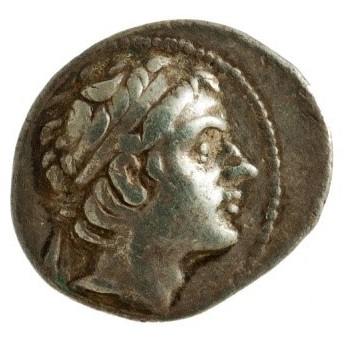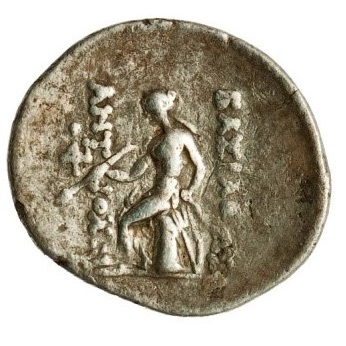Title: Drachma of Antiochos III Megas - 1983.03
Acquisition number: 1983.03
Author or editor: Douglas Kelly
Culture or period: Hellenistic.
Date: 222 - 187 BC.
Material: Metal - Silver
Object type: Coins - Greek
Dimensions: 21mm (w)
Origin region or location: Iraq
Origin city: Antioch.
Display case or on loan: 5
Keywords: Coin, Greek, Hellenistic, drachma, Antiochos III, Syria, Antioch, Apollo, Omphalos, Babylon
A. Houghton, C. Lorber and O. Hoover, Seleucid Coins: A Comprehensive Catalogue, 2 vols (New York, Lancaster and London, American Numismatic Society and Classical Numismatic Group, 2002 and 2008), 1047.
O. Hoover, Handbook of Greek Coinage 13 vols (Classical Numismatic Group, Lancaster, PA, 2009-2013), 9, 452d.
1983.03
Drachma of Antiochos III Megas
Silver 3.97 g. 21 mm. 222-187 BC.
Obv.: Diademed bust of Antiochos III, r., border of dots.
Rev.: Apollo seated l., on omphalos at Delphi, holding arrow and grounded bow. ΒΑΣΙΛΕΩΣ ΑΝΤΙΟΧΟΥ (‘of King Antiochos’), monogram in outer left field.
Sometimes known as Antiochos the Great, Antiochos III claimed the Seleukid throne at Babylon after the murder of Seleukos III, his elder brother. Less than twenty at the time, he needed some years to establish his authority. Nevertheless he had the full support of the army and soon showed himself to be a soldier of great ability. His military activities were too numerous to be covered here. Most notable were activities in the East where he attempted to emulate Alexander and to re-establish Seleukid authority as far as Baktria. In the early second century BC he came into conflict with the Romans and lost Seleukid possessions in Asia Minor.
Antiochos III struck a very large number of coins in gold and silver. Almost all of these coins carried his portrait on the obverse. Most reverses featured either the dynastic god Apollo or an elephant to emphasise military might. These issues often carry the legends ΒΑΣΙΛΕΩΣ ΑΝΤΙΟΧΟΥ (‘of King Antiochus’) or ΣΕΛΕΥΚΟΥ ΒΑΣΙΛΕΩΣ (‘of King Seleukos’).
In a number of cases of third- and second-century Seleukid coins, the obverse portraits and the reverses of kings (such as Antiochos III, Antiochos IV, Seleukos III and Seleukos IV) are similar. These coins usually have symbols and monograms, however, which help to distinguish which king has struck the coin. Later coins, such as the drachma of Demetrios II (1985.07), have extra text that identifies the king and eliminates problems of identification.
A. Houghton, C. Lorber and O. Hoover, Seleucid Coins: A Comprehensive Catalogue, 2 vols (New York, Lancaster and London, American Numismatic Society and Classical Numismatic Group, 2002 and 2008), 1047.
O. Hoover, Handbook of Greek Coinage 13 vols (Classical Numismatic Group, Lancaster, PA, 2009-2013), 9, 452d.

